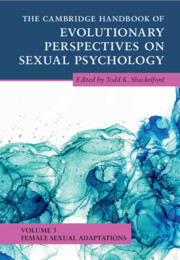Book contents
- The Cambridge Handbook of Evolutionary Perspectives on Sexual Psychology
- The Cambridge Handbook of Evolutionary Perspectives on Sexual Psychology
- Copyright page
- Contents
- Contributors
- Preface
- Part I Precopulatory Adaptations
- Part II Copulatory Adaptations
- Part III Postcopulatory Adaptations
- 13 Mate Retention
- 14 Shifts in Partner Attractiveness
- 15 Emotional Commitment
- 16 Female Sexual Jealousy
- 17 On Attachment and Evolution: Recounting the Story of, and Stories in, Attachment Theory
- 18 Maternal Filicide
- Index
- References
17 - On Attachment and Evolution: Recounting the Story of, and Stories in, Attachment Theory
from Part III - Postcopulatory Adaptations
Published online by Cambridge University Press: 30 June 2022
- The Cambridge Handbook of Evolutionary Perspectives on Sexual Psychology
- The Cambridge Handbook of Evolutionary Perspectives on Sexual Psychology
- Copyright page
- Contents
- Contributors
- Preface
- Part I Precopulatory Adaptations
- Part II Copulatory Adaptations
- Part III Postcopulatory Adaptations
- 13 Mate Retention
- 14 Shifts in Partner Attractiveness
- 15 Emotional Commitment
- 16 Female Sexual Jealousy
- 17 On Attachment and Evolution: Recounting the Story of, and Stories in, Attachment Theory
- 18 Maternal Filicide
- Index
- References
Summary
In this chapter, we provide a review of human attachment and bonding, from the perspective of attachment theory and with an eye towards evolutionary psychology and narrative methodologies. Attachment theory, a dominant paradigm in contemporary psychological science, is used to understand the processes by which people form, and the implications of, adaptive and maladaptive attachments across the lifespan. Distinct from its predecessors, including object relations theory and social learning theories of dependence, attachment theory is a curious combination of psychoanalytical, ethological, and evolutionary principles. Attachment theory was born out of an interest in understanding why infants desire a close physical proximity to their caregivers. This phenomenon is explained by the existence of an innate attachment behavioral system, a system that has evolved to aid the likelihood of survival throughout infancy and childhood and, later, reproduction. At the heart of the attachment behavioral system lies the internal working model of close relationships, believed to be largely formed on the basis of experiences in infancy and, to a lesser degree, beyond. Caregivers who are available and appropriately responsive are thought to contribute to the development of a secure attachment model, one in which the individual is comfortable depending on caregivers, and later being depended upon. When caregivers are less reliable, the attachment behavioral system may become upregulated, leading to an anxious orientation, defined by hypersensitivity to others’ availability and a preoccupation with potential loss and separation, or downregulated, leading to an avoidant orientation, defined by a desire for separation and independence. The attachment construct, which has been assessed using behavioral, projective, interview, and self-report methodologies, carries implications for functioning from the infant to the elderly, as well as the varied relationships that are entertained between these periods. In adulthood, romantic attachment may be plotted along continuous dimensions of anxiety and avoidance. These constructs are most often considered via self-report measures in which participants rate their affect, behaviors, and cognitions within romantic relationships. Incorporating evolutionary principles and life history theory, some have predicted, and some have found, sex differences in levels of insecure romantic attachment, with males demonstrating comparably heightened levels of avoidance and females demonstrating comparably heightened levels of anxiety. Here, we further exemplify this finding via the life stories of a small number of male and female cases with varying levels of avoidance and anxiety. As a species, we have evolved to possess both (i) a complex attachment behavioral system designed to help us thrive in the social world, and (ii) a tendency to perceive the social world, ourselves, and our relationships as a story. We conclude by signaling the need for further work exploring attachment, evolution, and lived experience.
Keywords
- Type
- Chapter
- Information
- Publisher: Cambridge University PressPrint publication year: 2022



